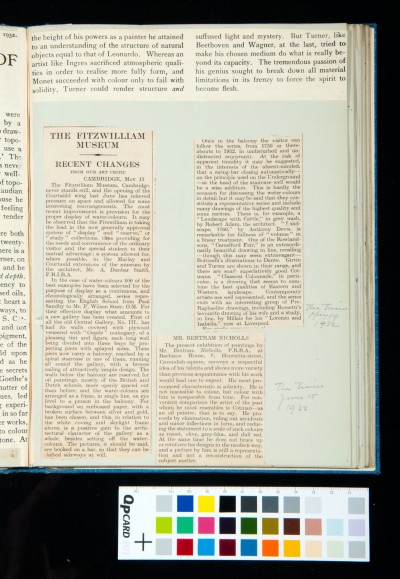Cotmania. Vol. VII. 1931-2
Archive: SDK Sydney Decimus Kitson Archive
Reference Number: SDK/1/2/1/7
Page: 16 recto
-
Description
Lecture on English watercolour artists by Rienaecker; report on Fitzwilliam Museum; Bertram Nicholls exhibition
Continuation of lecture by Rienaecker; changes in display of watercolours in the Fitzwilliam Museum, Cambridge; exhibition in London of paintings by Bertram Nicholls, who is said to resemble Cotman.
Date: 1932
-
Transcription
the height of his powers as a painter he attained to an understanding of the structure of natural objects equal to that of Leonardo. Whereas an artist like Ingres sacrificed atmospheric qualities in order to realise more fully form, and Monet succeeded with colour only to fail with solidity. Turner could render structure and suffused light and mystery. But Turner, like Beethoven and Wagner, at the last, tried to make his chosen medium do what is really beyond its capacity. The tremendous passion of his genius sought to break down all material limitations in its frenzy to force the spirit to become flesh.
THE FITZWILLI AM MUSEUM
RECENT CHANGES
FROM OUR ART CRITIC
CAMBRIDGE, MAY 13
The Fitzwilliam Museum, Cambridge, never stands still, and the opening of the Courtauld wing last June has relieved pressure on space and allowed for some interesting rearrangements. The most recent improvement is provision for the proper display of water-colours. It may be observed that the Fitzwilliam is taking the lead in the now generally approved system of "display" and "reserve," or "study" collections, thus providing for the needs and convenience of the ordinary visitor and the special student to their mutual advantage; a system allowed for, where possible, in the Marlay and Courtauld extensions of the museum by the architect, Mr. A. Dunbar Smith, F.R.I.B.A.
In the case of water-colours 100 of the best examples have been selected for the purpose of display in a continuous, and chronologically arranged, series representing the English School from Paul Sandby to Mr. P. Wilson Steer, O.M. For their effective display what amounts to a new gallery has been created. First of all the old Central Gallery, No. III., has had its walls covered with plywood veneered with "Cepele" mahogany, of a pleasing tint and figure, each long wall being divided into three bays by projecting piers with splayed sides. These piers now carry a balcony, reached by a spiral staircase in one of them, running all round the gallery, with a bronze railing of attractively simple design. The walls below the balcony are reserved for oil paintings, mostly of the British and Dutch schools, more openly spaced out than before, and the water-colours are arranged as a frieze, in single line, on eye level to a person in the balcony. For background an embossed paper, with a broken surface between silver and gold, has been chosen, and this, in relation to the white coving and skylight frame above, is a positive gain to the architectural character of the gallery as a whole, besides setting off the water-colours. The pictures, it should be said, are hooked on a bar, so that they can be shifted sideways at will.
Once in the balcony the visitor can follow the series, from 1750 or thereabouts to 1932, in undisturbed and undistracted enjoyment. At the risk of apparent timidity it may be suggested, in tho interests of the absent-minded, that a swing-bar closing automatically—on the principle used on the Underground—at the head of the staircase well would be a wise addition. This is hardly the occasion for discussing the water-colours in detail, but it may be said that they constitute a representative series and include many drawings of the highest quality and some rarities. There is, for example, a "Landscape with Cattle," in grey wash, by Robert Adam, the architect. "Landscape, 1760," by Anthony Devis, is remarkable for fullness of "volume" in a linear treatment. One of the Rowlandsons, "Camelford Fair," is an extraordinarily beautiful drawing in line, recalling—though this may seem extravagant—Botticelli's illustrations to Dante. Girtin and Turner are shown in their range, and there are some superlatively good Cotmans. "Classical Colonnade," in particular, is a drawing that seems to combine the best qualities of Eastern and Western landscape. Contemporary artists are well represented, and the series ends with an interesting group of Pre- Raphaelite drawings, including Rossetti's favourite drawing of his wife and a study, in line, by Millais for his "Lorenzo and Isabella,'" now at Liverpool.[Note by Kitson:] The Times May 14 1932
MR. BERTRAM NICHOLLS
The present exhibition of paintings by Mr. Bertram Nicholls, P.R.B.A., at Barbizon House, 9, Henrietta-street, Cavendish-square, conveys a respectful idea of his talents and shows more variety than previous acquaintance with his work would lead one to expect. His most pronounced characteristic is sobriety. He is not insensible to colour, but colour with him is inseparable from tone. For convenient comparison the artist of the past whom he most resembles is Cotman—as an oil painter, that is to say. He proceeds by elimination, ruling out accidents and minor inflections in form, and reducing the statement to a scale of such colours as russet, olive, grey-blue, and dull red. At the same time he does not brace up or reinforce his designs in the modern way, and a picture by him is still a representation and not a reconstruction of the subject matter.
[Note by Kitson:] The Times June 15 1932
